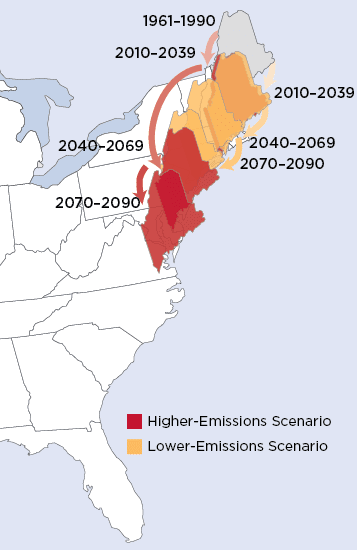Ironies, like onions, come in layers and can make you cry.
As I stared at a graphic showing an outline of Maine symbolically shifting down the East Coast (see figure), I had an unsettling sense of déjà vu. The image depicted how – a few decades hence – summers in Maine will feel like those in New York and, by 2070, could resemble those around the Chesapeake Bay.
I grew up enduring Maryland’s sauna-summers. At age 17, I fled north to Maine when high school ended, not even waiting for graduation.
Yet every year since, powered by rising CO2 emissions, Maine has been sliding toward those sultry summers I thought I’d escaped.
Adding another layer of irony, I knew of that projected warming while still in high school. Climate change wasn’t a household word in 1981, but my father had introduced me to a prescient book called “Hothouse Earth,” written by his colleague, Howard Wilcox.
A physicist well-versed in marine science, Wilcox recognized threats posed by what he termed “global thermal pollution” and foresaw the danger of rising seas from melting polar ice caps. He realized that glacial melting would start slowly (“the catastrophe will gather its forces bit by bit”). Then, as surfaces no longer covered in ice absorbed more solar radiation, the melting and flooding would accelerate.
Concerned by those projections, I wrote a senior-year paper on “Atmospheric Carbon Dioxide: Earth’s Invisible Insulator.” The science underlying climate disruptions struck me as novel then, but it turned out that it was far from new.
In the mid-1800s, Irish physicist John Tyndall figured out that carbon dioxide and other atmospheric gases could trap heat. And by 1900, Swedish chemist and physicist Svante Arrhenius calculated how much warming would occur with a doubling of atmospheric carbon dioxide.
The National Academy of Sciences issued a report in 1977 linking global warming to increased fossil fuel use. Further research confirmed those links, and there seemed to be the consensus necessary to shift energy policy. Even Exxon Corporation published research results affirming that cuts in fossil-fuel combustion were needed to reduce catastrophic climate consequences.
By 1985, the year the United States helped negotiate an international agreement to protect the ozone layer, we should have been on our way to reducing the fossil fuels cooking our planet.
That didn’t happen, clearly. Or I wouldn’t have sat recently staring at that disturbing graphic of Maine’s southward-shifting climate as a group of high-school students presented on the very-same crisis I wrote about at their age – decades ago.
How on earth did we get here? And why do we still have leaders – especially a U.S. president – seemingly immune to demonstrable scientific evidence?
The answers are complex, but some insights can be found in a troubling timeline of U.S. and international climate policy, a “Climate Chronology,” created by Sharon Tisher, an environmental lawyer and longtime lecturer at the University of Maine.

The timeline began simply as a teaching aid for Tisher’s own use in a climate-focused class on energy and law that she has taught since 2012. Having worked as a trial attorney, she was accustomed to organizing cases with a chronology, so she began assembling notable climate policy events and related scientific findings.
The document “just grew and grew,” she recalls; it’s now at 171 pages and keeps expanding. At first, she shared the timeline with students to help guide their research since each short entry has hyperlinked sources.
Then she circulated the chronology more broadly through Listservs of the nonprofit Climate Reality Project, receiving responses from all over the world. Because the United States is a linchpin to reducing global emissions, “people are really interested in what’s going on here and why it happens.”
For Tisher, one “huge irony” at the core of the climate crisis is that the United States – the largest historical producer of CO2 emissions – has “done the most to hold back the international community” in treaties aimed at reining in carbon pollution.
Even before President Trump announced a U.S. withdrawal from the Paris climate accord in 2017, Tisher says, there was “overt opposition and more subtle subversion all along the way.”
The chronology, she adds, portrays a recurrent pattern showing “how long the science developed before there was anything in the way of a policy response.”
Rachel Carson, for example, warned in 1951 in her best-selling book “The Sea Around Us” of a “startling alteration of climate” in which the “frigid top of the world is very clearly warming up.” Yet, it was more than three decades before the U.S. government even began to consider actions to reduce greenhouse gas pollution.
“That disjunction just continues,” Tisher reflects, a “disconnect that is both fascinating and tragic.”
Closing that gap between science and policy may depend on a more informed public, and Tisher hopes that the Climate Chronology will help. She’s seeking grant funds to upgrade the timeline into an illustrated, interactive website that could reach and engage more people.
The climate crisis is “the biggest challenge ever to face” our species, Tisher says. Milestones mapped on the chronology help to show how we reached this point of reckoning.
The decades lost make action now that much more critical. Tisher tells her students, “There’s no more important time to be a human on this planet.”







